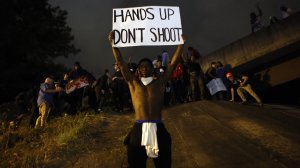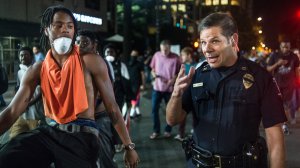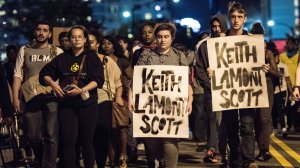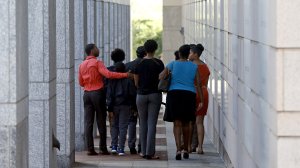Relatives of Keith Lamont Scott, after watching two police videos, said they couldn’t say what was in his hands when he was shot and killed by a Charlotte police officer.

“It is impossible to discern from the videos what, if anything, Mr. Scott is holding in his hands,” attorney Justin Bamberg said.
The family wants police to immediately release the videos to the public, Bamberg said.
But Charlotte-Mecklenberg police Chief Kerr Putney told reporters earlier Thursday that he’s not going to do that because he doesn’t want to jeopardize the investigation.
Asked whether there was a time at which the public could expect to see it, Putney said there should be no such expectation.
“Transparency’s in the eye of the beholder,” he said. “If you think we should display a victim’s worst day for public consumption, that is not the transparency I’m speaking of.”
Putney later told CNN’s Wolf Blitzer the decision wouldn’t be his to make much longer anyway, as the investigation was being turned over to North Carolina’s State Bureau of Investigation.
Putney said video does not provide “definitive visual evidence” that Scott pointed a gun at police officers, including Brentley Vinson, who shot Scott. But other evidence and witness accounts support the police narrative that officers opened fire only after Scott refused to drop his weapon, he said.
The family says the video shows Scott acting calmly and non-aggressively on Tuesday. “When he was shot and killed, Mr. Scott’s hands were by his side and he was slowly walking backwards,” Bamberg said.
Scott didn’t own a gun or habitually carry a gun, the family has told their attorneys, Bamberg said. Scott’s family has said he was reading a book in his vehicle when officers approached.
Mayor Jennifer Roberts also watched the videos.
“It is not a very clear picture, and the gun in question is a small gun and it was not easy to see with the way the motion was happening,” she told “Anderson Cooper 360.”
The mayor said she is leaning toward releasing the footage to the public, but must remain mindful of the ongoing investigations into Scott’s shooting.
Shooting victim dies
The man shot outside Charlotte’s Omni Hotel during Wednesday night’s violent protests over Scott’s death has died, police public information officer Robert Tufano told CNN.
The victim was identified as Justin Carr, 26, from Charlotte.
Carr was discovered at the Omni Hotel uptown, and because the crowd was too thick for paramedics to access the scene, he had to be evacuated by a SWAT armored personnel carrier, the chief said. Authorities have said he was shot by another civilian.
Fears of violent protests
After violent protests raged for the second night in Charlotte, residents were uneasy Thursday as a state of emergency was in effect and National Guard troops arrived.

On Wednesday, police arrested 44 people at the protests, one of which turned into a riot. People smashed windows, looted storefronts and threw objects at others and police.
Mayor Jennifer Roberts has signed an order enacting a curfew for the city, an aide told CNN. The curfew goes into effect at midnight and extends until 6 a.m. EST.
“The curfew will be in effect each day until the end of the State of Emergency is declared or until the official proclamation is revoked,” the city tweeted.
Several hundred people gathered Thursday night on streets in uptown Charlotte; the demonstrations appeared largely peaceful.
Putney used a news conference to send a message to those who would continue looting and destroying property in the city, which also resulted in injuries to nine civilians and five police officers.
Two of the officers suffered minor eye injuries, while three others had heat-related ailments.
Wednesday’s protests began peacefully, the chief said, but about 8 p.m. demonstrators began jumping on cars and damaging property at EpiCentre, an entertainment hub uptown. Police were forced to deploy tear gas, he said, and as the night went on, protesters shut down Interstate 277 and the city’s light rail was halted just before midnight, due to the demonstrations, Putney said.
The violence and vandalism carried on until roughly 3 a.m., he said. The arrests ran the gamut from failing to disperse to assault to breaking and entering, and more arrests may come as authorities review video footage of the protests, he said.
Those looking to repeat the tumult will do so under an increased police presence Thursday night. There will be officers on foot and bike patrol, as well as dirt bikes. Helicopters will patrol the streets from above, and police will have more than 1,000 cameras to help monitor the city, Putney said.
The National Guard and state police will protect buildings and infrastructure so the Charlotte-Mecklenburg police can “focus on the people who are committing crimes, who are damaging property and assaulting our people,” he said.
Guard troops were seen arriving Thursday afternoon and the state was in the process of activating 316 troops for security and crowd control.
What’s on the video?

While the public shouldn’t expect to see the video, Todd Walther, spokesman for the Charlotte Fraternal Order of Police, told CNN that he viewed the footage, and it demonstrated Scott was “an obvious threat” to police officers. He said Scott can be seen with a gun and ankle holster in the video.
Scott was in a vehicle when police arrived to serve a warrant on another man at an apartment complex, he said. Some of the officers were not in uniform, but they still had vests or jackets that said “police” on the front and back, Walther said.
“He was seated in (the car) when he was approached, but when he exited that vehicle, he was given clear commands to drop the weapon — and he did not do that,” Walther said. “So he was armed when he came out of that vehicle and refused to listen to officers.”
A photo obtained by CNN affiliate WSOC shows the immediate aftermath of the shooting of Scott, a source close to the investigation told CNN.
A black object near the bottom of the photo is a gun found by police at the scene, the source said.
Family disputes account
Scott’s family has said he was reading a book when police officers approached his vehicle and shot him. But Putney said Scott was armed and no book was found at the scene.

Moments after her father was shot, Lyric Scott started recording on Facebook Live, screaming at officers on the scene.
“They shot my daddy ’cause he’s black,” she said. “He was sitting in his car reading a mother******* book. So they shot him. That’s what happened.”
North Carolina recently passed a law that blocks the release of police recordings from body or dashboard cameras with limited exceptions, but that law is not set to take effect until October.
“Technology like dashboard cameras and body cameras can be very helpful, but when used by itself technology can also mislead and misinform, which causes other issues and problems within our community,” Gov. Pat McCrory said after signing the bill into law in July.
Victim in critical condition
The perceived lack of transparency has fueled widespread anger in Charlotte, prompting McCrory to declare a state of emergency overnight.
While there were instances of peaceful demonstration throughout the city, some rioters overturned trash cans and set the contents on fire Wednesday night.
Onlookers cheered as a masked man shattered a hotel window while another one hurled rocks through it. Others spray-painted “Black Lives Matter” on business facades and smashed car windows.
‘It was madness’
“I was right in the thick of it,” witness Zach Locke said. “People found whatever objects they could to break glasses. It was madness.”
Stores were looted, and freelance photographer Marcus DiPaola told CNN he saw people knock over an ATM and grab money from it.
The Hyatt House Hotel downtown went into lockdown as protesters tossed bricks through the window. Protesters punched a valet and front desk attendant in the face, hotel manager Matt Allen said.
Not all the protests were violent.
Kristine Slade, 19, a University of North Carolina at Charlotte student, joined the protests Tuesday night, kneeling in front of a police line with her hands up in the air. She said she felt like she had to protest, because “if nobody else is going to do it, then we’re still going to be in the same position.”
But she became increasingly worried Wednesday night as she saw rocks being thrown, fires being set and acts of vandalism committed. She left early when police tried to disperse the crowd.















